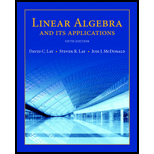
In Exercises 1-6, the given set is a basis for a subspace W. Use the Gram-Schmidt process to produce an orthogonal basis for W.
3.
Want to see the full answer?
Check out a sample textbook solution
Chapter 6 Solutions
Linear Algebra and Its Applications (5th Edition)
Additional Math Textbook Solutions
Elementary & Intermediate Algebra
University Calculus: Early Transcendentals (4th Edition)
Introductory Statistics
A Problem Solving Approach To Mathematics For Elementary School Teachers (13th Edition)
Finite Mathematics for Business, Economics, Life Sciences and Social Sciences
Calculus for Business, Economics, Life Sciences, and Social Sciences (14th Edition)
- Can we have an exponential equation using logarithm however i want to show that one mistake is involved in solving it. Showing the mistake and how to be fixed. Thanks.arrow_forwardIs it possible to show me how to come up with an exponential equation by showing all the steps work and including at least one mistake that me as a person can make. Like a calculation mistake and high light what the mistake is. Thanks so much.arrow_forwardConsider the weighted voting system [16: 15, 8, 3, 1]Find the Banzhaf power distribution of this weighted voting system.List the power for each player as a fraction: P1: P2: P3: P4:arrow_forward
- Solutions of inequalitie Google Classroom Mic Is (-3, 2) a solution of 7x+9y > -3? Choose 1 answer: A Yes B No Related content ▶6:06 Testing solutions to inequalities 2 of 4arrow_forwardAre natural logarithms used in real life ? How ? Can u give me two or three ways we can use them. Thanksarrow_forward?arrow_forward
- Solve the equation. Write the smaller answer first. 2 (x-6)² = 36 x = Α x = Previous Page Next Pagearrow_forwardWrite a quadratic equation in factored form that has solutions of x = 2 and x = = -3/5 ○ a) (x-2)(5x + 3) = 0 ○ b) (x + 2)(3x-5) = 0 O c) (x + 2)(5x -3) = 0 ○ d) (x-2)(3x + 5) = 0arrow_forwardA vacant lot is being converted into a community garden. The garden and a walkway around its perimeter have an area of 690 square feet. Find the width of the walkway (x) if the garden measures 14 feet wide by 18 feet long. Write answer to 2 decimal places. (Write the number without units). Hint: add 2x to each of the garden dimensions of 14 x 18 feet to get the total area for the length multiplied by width.arrow_forward
 Elementary Linear Algebra (MindTap Course List)AlgebraISBN:9781305658004Author:Ron LarsonPublisher:Cengage LearningAlgebra & Trigonometry with Analytic GeometryAlgebraISBN:9781133382119Author:SwokowskiPublisher:Cengage
Elementary Linear Algebra (MindTap Course List)AlgebraISBN:9781305658004Author:Ron LarsonPublisher:Cengage LearningAlgebra & Trigonometry with Analytic GeometryAlgebraISBN:9781133382119Author:SwokowskiPublisher:Cengage Linear Algebra: A Modern IntroductionAlgebraISBN:9781285463247Author:David PoolePublisher:Cengage Learning
Linear Algebra: A Modern IntroductionAlgebraISBN:9781285463247Author:David PoolePublisher:Cengage Learning


